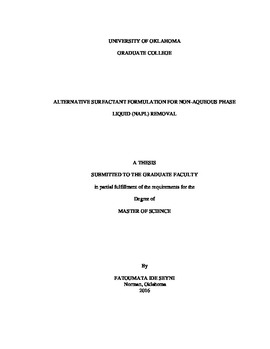| dc.description.abstract | Due to the inefficiency of the pump and treat method in removing hydrocarbon contamination from ground water, a new method called surfactant Enhanced Aquifer remediation (SEAR) has been developed. SEAR is just a chemical enhancement to the pump and treat method that consists of using surfactants to increase the solubility of the oil phase in the water and thus increase the removal of contaminants. A surfactant solution composed of 0.75 wt.% AOT and 0.19 wt.% Calfax 16L-35 was developed as a formulation for SEAR application. However, the limited biodegradability of the Calfax 16L-35 has led to the need for an alternative surfactant system. An alternative formulation composed of .75 wt.% AOT and 0.19 wt.% SDBS was developed and showed promising results. In this work, a new surfactant is introduced, called the Taiwan surfactant, and is tested to determine whether it can be used by itself in a SEAR application. The results of this work show that a 0.94 wt.% Taiwan surfactant formula meets all the criteria set for a SEAR application; it can form a middle phase microemulsion near 1 g NaCl/100 ml at room temperature with octane, it has a low adsorption on sand, a good oil mobilization capability and is stable. Furthermore, the performance of this system is comparable to the performance of the AOT/SDBS system meaning that either one of these two formulations can be use in place of the AOT/Calfax 16L-35 system.
The second part of this work focused on finding the HLD parameters of the surfactants of interest and on determining the accuracy of the HLD equation in predicting the optimum salinity of the three systems. An updated method was used in place of the Acosta’s method to find the parameters, and the two methods were compared. It is shown in this work that both methods have limitations, but they both give good approximations for the HLD of our three systems. Lastly, it is shown that the HLD method is a good correlation for describing microemulsion systems. | en_US |
